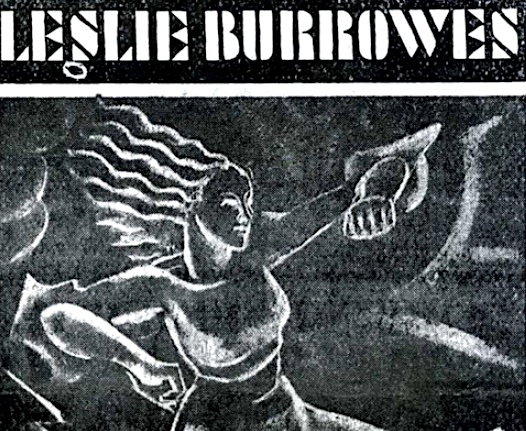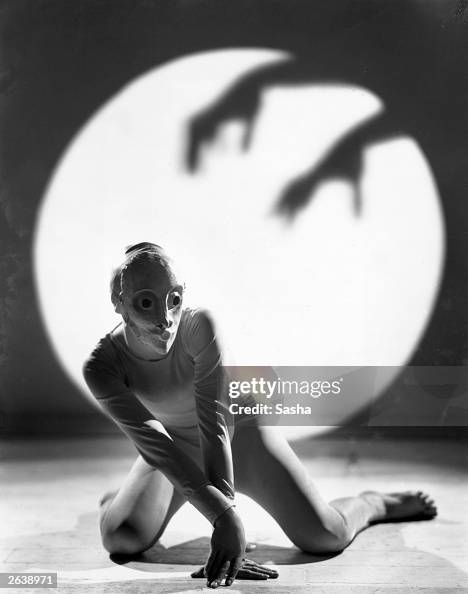OTD in early British television: 19 May 1933

John Wyver writes: The line-up for the BBC’s 30-line transmission starting at 23.03 on Friday 19 May 1933 featured Russian singer Dimitri Vetter together with Lilian Lloyd-Taylor ‘with songs and costumes of the seventeenth century’. But the most interesting featured performer, at least for those of us interested in modern(ist) dance, was Leslie Burrowes, who gave her solos ‘Fear’, ‘Three Studies from a Celtic Suite’ and ‘Pastoral Dance’.
Born in 1908, Leslie Burrowes, according to The Routledge Encyclopaedia of Modernism,
had studied and performed with Margaret Morris, whose ‘free dance’ method belonged to the Hellenic and Duncanesque nonballetic dance techniques of early twentieth-century Britain. Burrowes rejected her original dance training in favor of [Mary] Wigman’s expressionism, returning to London in 1931 to proselytize on its behalf and to serve as Wigman’s official British representative. Burrowes’ attempts to establish Wigman’s dance in Britain were largely unsuccessful, caught in the squeeze between the better-established ballet and Hellenic dance.
She had already appeared in a 30-line broadcast in March 1933, and she would return to the studio in October, and then twice more under her married name of Leslie Goossens in February and July 1935, on each occasion giving a different selection of solos.
Burrowes is the subject of a richly detailed 2010 Dance Research journal article ‘Leslie Burrowes: A Young Dancer in Dresden and London, 1930-34’ by Larraine Nicholas (available open access here). This focuses on Burrowes’ professional life from the point when she went to study with Mary Wigman in Dresden to when she was back in London teaching and struggling to establish herself as a professional dancer. Nicholas doesn’t mention her television appearances, but her article is fascinating for the context that it provides for these transmissions.
Nicholas’ article reproduces a number of letters, accompanied by a thoughtful commentary, that Burrowes wrote from Dresden to her patron, Dorothy Elmhirst, who along with her husband Leonard had bought Dartington Hall in 1925. From 1928 Burrowes taught dance at the school the American couple founded there, before going to the academy set up in Dresden by Mary Wigman, a protegé of both Émile Jacques-Dalcroze and Rudolph Laban and a celebrated pioneer of modern dance who performed in London in 1928.
Burrowes returned to London in the autumn of 1931, and gave her first London recital on two evenings in December. These were followed by further solo recitals in July 1932 and December 1933, and as Nicholas notes, ‘those three recitals of solo dances in London theatres stand out as a supreme effort which was not repeated later in her career.’ Further, of one of the pieces she performed for the screen in May, Nicholas writes,
‘Fear’ was a masked dance with a heart-like drumbeat for accompaniment, subtitled rather impenetrably, ‘a study of an immature elemental’.
A striking photograph by ‘Sasha’ of this performance gives a strong sense of this work.

In the earlier transmission Burrowes performed ‘Primitive Joy’,
a dance that became her signature piece, used all sound possibilities of percussion, stamping, clapping and voice. The costume was a brief tunic in red and the percussion developed out of the composition of song and foot rhythm. One of her later students said that it was ‘a true expression of her vivacious personality . . . a dance of superb elevation, quickness and lightness’
Nicholas also summarises the ambivalent press reaction to her recitals:
there is a noticeable division between positive assessments of her as a dancer and some degree of incomprehension of her art form. Strong technique, vitality, youth and good looks were all on her side but modern dance, with its tendency to austerity and introspection was seen as having limitations, especially in solo performance.
Increasingly, however, both to earn a living and because of her commitment to pedagogy, Burrowes dedicated her time to teaching, and with support from the American artist Lisel Drake and her British husband Eric, she established the Leslie Burrowes Studio of the Dance. She was also married by this point to the oboist Léon Goossens.

Advertisement for the Leslie Burrowes Studio of the Dance (with detail in header image), design by Lisel Drake, 1933. National Resource Centre for Dance, Leslie Burrowes Collection.
Although it leaves its subject in 1934, Nicholas’ detailed and nuanced discussion, situates Burrowes in the wider context of British dance in the mid-1930s:
this was certainly a period of potential for modern dance in Britain with positive as well as negative responses from critics, educators and other supporters and the possibility of spearheading the break between the dance of the past and the dance of the future…
But Burrowes had to negotiate a different cultural climate in which the mystique of the ‘priest of the dance’, that seemed so valid to her in Dresden, had no influence. Her ideology was tested by notions of what was alien and what properly ‘English’ as well as the need to retain and disseminate the Wigman method in which she believed.
As with almost all of the 30-line broadcasts between 1928 and 1935, we have no recordings or photographs of Burrowes’ performances, and we have only bare listings of the works performed: ‘Figurine’ and a medley of a bolero, tango and mondina, along with ‘Primitive Joy’ in March; the titles noted above in May; and ‘Madonna’, ‘Suite of two percussion dances’ and ‘Waltz’ in October; then in February 1935, ‘Rush Hour’, a mask dance also seemingly known as ‘The Fantastic Ballet’, ‘March’ to Prokofiev, and ‘To a Pavane’, with music by Byrd; and in July, ‘The Bird’, ‘Tenpenny Bit’ and ‘I Call on Thee Lord’, this latter to Bach.
Pleasingly, however, there is one extended review of her first television appearance, featured in the ‘Last month’s programmes’ column of the monthly journal Television, April 1933 (which may well have been written by one of the studio engineers, Tony Bridgewater):
A really striking perforance was given by Leslie Burrows (sic). Like Isadora Duncan in her time, this dancer has something new to offer. She is idealistic and her school is dedicated ‘to those thousands, untutored in the rich speech of the body, who might gain in life through physical and emotional exercise.’
Her technique consists in the study and mastery of the body through control and co-ordination until a perfect harmony is attained. No set method is used and no series of steps or positions is taught and each pupil is encouraged to find his or her individual ‘scale’ through experience of every kind of expression.
This is a fresh conception of dancing and its definition has helped me to understand her ‘Primitive Joy’ last item in her programme. It was danced with short sharp cries to the accompaniment of tom-toms, made from logs imported from Chelsea and beaten by two students from the school. Stamping was a prominent feature of its movement.
In her first dance, a ‘figurine,’ the melody was played on a clarinet and the dancer wore a white maskwith long black eyelashes. Close-up work with arms alone faded to full figure dancing before the extended screen, returning to close-up.
Eyes and ears become more tolerant as increasing noise and movement in daily experience tend to dull the senses. As a result music becomes more strident and movement more bizarre in order to seize and hold attention.
We may see and hear a good deal of this expressionistic form of dancing and as Leslie Burrowes is its foremost available exponent we must have her again in the studio. Aesthetic judgement awaits further experience and in the meantime I am interested. Anyway, it is fun.
Leslie Burrowes’ presence across these five late-night broadcasts to tiny audiences is yet one more indication of the range and ambition of these early transmissions, and of producer Eugene Robb’s deep commitment to the modern dance scene in Britain.
[OTD post no. 153]
Leave a Reply